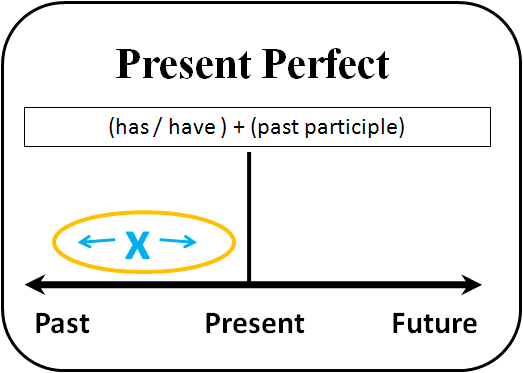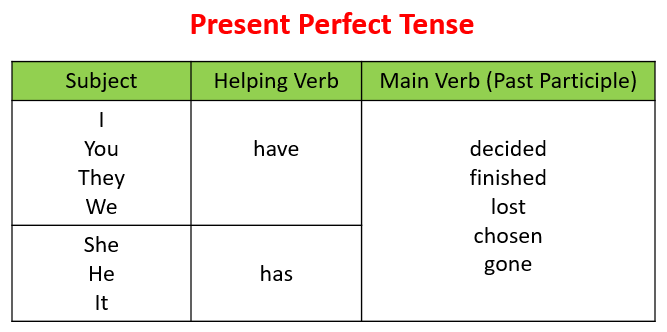- What does Present Perfect mean?
- Use of time expressions
- How do you form Present Perfect?
- How do you use Present Perfect?
- Present Perfect Tense for Unfinished Past
- Present Perfect Tense with ‘Just’/’Already’ and ‘Yet’
- Present Perfect Tense for Experience
- Other common usages of Present Perfect are:
- Common signal words
- Present Perfect Passive: meaning
- Present Perfect Passive: usage
- In general, we use Passive voice instead of Active voice when:
- Present Perfect Passive: structure
- Statements
- Negative forms of Present Perfect Passive
- Questions in Present Perfect Passive
The Present Perfect is one of the most challenging verb tenses for English learners. It is used in certain situations and often with quite different meanings. But with some good reference at hand and regular practice, you can easily get into using it! Let’s review when we should use the Present Perfect in the Active voice and then see how it can be used in the Passive.
What does Present Perfect mean?
The Present Perfect tense denotes an action or state that occurred at an indefinite time in the past (e.g., we have met before) or began in the past and continue to the present time (e.g., I’ve worked here for five years). These actions have started in the past but continue up to the present moment.



See? It’s always related to the past and irrespective of its name ‘Present Perfect’ expresses a past event.
But why is it called “Present Perfect”?
Present Perfect is called like that because it combines the present grammatical tense (she has) and the perfect grammatical aspect (done). The Present Perfect is used to denote a link between the present and the past. It expresses actions in the past that still have an effect on the present moment.
- My new bicycle has been delivered already, so now I can ride it all day long.
- Your dog looks sad, has it been fed today?
- Old chairs in the hall have been replaced with the new ones.
The time of the action is before now but not specified, and we are often more interested in the result than in the action itself.
- Why is she sad?
- She has read your letter.
- Why are you going outside?
- My boyfriend has arrived.
Use of time expressions
The Present Perfect uses time adjuncts referring to the present and does not allow the use of time adjuncts referring to the past.
- We have completed our project by now.
- We have finished our work last week. (incorrect)
- We finished our work last week. (Past Simple should be used instead)
How do you form Present Perfect?
The construction of the Present Perfect is simple. The first element is the auxiliary (helping) verb ‘have‘ or ‘has‘, depending on the subject the verb is connected with. The second element is the past participle of the verb.



In most cases (for regular verbs), to form the Past Participle we add ‘-ed’ to the base form of the verb:
- to listen → listened
- to like → liked
- to drop → dropped
| See spelling rules for verbs when adding ‘-ed’ here. |
| Some common verbs in English have irregular Past Participle forms: |
| – go – went – gone – be – was/were – been – feel – felt – felt, etc. You should remember them or consult a dictionary or irregular verb list. |
Read the examples with Present Perfect:
- We have worked here since 2008.
- We have seen this movie already.
- I have made you a cup of tea.
- He has cut his finger.
How do you use Present Perfect?
Present Perfect is typically used to describe:
- Unfinished past
- Past actions or events that have an effect in the present
- Experience
- Other actions when the emphasis is on the result, not the process
Present Perfect Tense for Unfinished Past
We may use the Present Perfect to talk about actions or events that started in the past but continue to the present or to describe something we have done several times in the past and continue to do:
- I’m a teacher.
- I started teaching five year ago.
- I’ve been a teacher for five years.
- I have a bike.
- My Dad gave it to me a long time ago.
- I’ve had it for ages.
Present Perfect Tense with ‘Just’/’Already’ and ‘Yet’
We use the Present Perfect to talk about actions or events in the past that still have an effect on the present moment. These actions have started in the past but continue up to the present moment.
We can use ‘just’ or ‘already‘ to talk about something that happened a short time ago:
- I have just came from school.
- They have just cooked dinner.
We often use ‘yet’ with negative and question forms of the Present Perfect. It means something like ‘until now’. It usually comes at the end of the sentence.
- Has he arrived yet?
- I haven’t seen Susan yet.
Present Perfect Tense for Experience
We use the Present Perfect to ask about life experiences. We often use the adverb ‘ever’ to talk about experience up to the present:
- I’ve been to India twice.
- She hasn’t eaten sushi.
This tense expresses actions of duration that occurred in the past (before now) but are of unspecified time:
- Tom has been to London.
- Have you ever met George?
- Yes, but I’ve never met his wife.
Other common usages of Present Perfect are:
- To put emphasis on the result: – She has broken a cup.
- To express an action that started in the past and continues up to the present: – I have worked for this company for 10 years.
- To talk about life experiences: – I’ve never traveled alone.
- To say about an action repeated in an unspecified period between the past and now: – I have visited them many times.
- When the precise time of action is not important or unknown: – Someone has stolen my bike!
Remember: the focus of the Present Perfect is mainly the result we have in present.
We’ve revised the Present Perfect tense in the Active voice. Let’s see what’s the difference between Present Perfect Active and Present Perfect Passive.
Common signal words
Present Perfect is often used with the words like ‘just‘, ‘already‘, recently‘, lately‘, ‘still‘, ‘this week/month/year‘, today’, etc. to denote a recent activity or event.
In statements showing an event or situation which began in the past and continues now, we often use time expressions with since and for, e.g. for a week, since yesterday, for a long time, since 2010:
We use:
| for + | ages / ten years / six months / two weeks / fifteen minutes |
| a period of time |
| since + | 2015 / March / last summer / yesterday / this morning / 10.00 |
| a point in time |
- I love my new office, I’ve worked there for five months already.
- Today we celebrate our anniversary, we’ve been married since 2007.
Present Perfect Passive: meaning
The Present Perfect Passive is an English verb form that has the present tense, perfect aspect, and passive voice. In the Passive, a subject of the sentence is not the doer – it is acted upon. We focus attention on what or who receives an action (the object).
Compare:
- Lise has recorded a song. – A song has been recorded by Lisa.
- Everybody has approved Joana’s suggestion. – Joana’s suggestion has been approved by everybody.
We use Present Perfect Passive with the same meaning as Present Perfect in the active voice except for the fact that Present Perfect Passive makes focus on the effect (or the object) rather than the doer (the subject) of an action. Read more about the uses of Present Perfect in our articles Present Perfect Tense for Unfinished Past, Present Perfect Tense with ‘Just’ and ‘Yet’ and Present Perfect Tense for Experience.
In the picture below, you can see the word order changes in the Passive voice – the subject and the object of the sentence change places.



Thus, the main difference between the Present Perfect Active and the Present Perfect Passive in terms of grammar and semantics is that the Present Perfect Passive allows for an object of an active sentence to move into the subject position of a passive sentence.
Present Perfect Passive: usage
We use the Present Perfect in the passive form for all the same reasons we use it in the active form — to talk about (1) experiences and achievements, (2) changes over time, (3) incomplete actions with expected ends, (4) continuous actions started in the past, (5) past actions with results in present, and (6) multiple actions at different times. For example:
- All the sandwiches have been eaten.
- Maths has been studied for many years.
- The light has been turned on already.
- All the patients have been treated by Dr Philips.
In general, we use Passive voice instead of Active voice when:
1. The subject is unknown. We don’t know who or what is the subject.
- An amazing surprise has been prepared for you.
2. We want to emphasize the subject.
- Only ‘she’ has been known to be always in time.
3. We are unclear or vague about the subject or the subject is irrelevant.
- The results of the degree examination have been announced.
4. To talk about general truths.
- These lands have been cultivated for as long as we know it.
5. In formal writing (such as scientific reports) when the emphasis is on process and results, rather than on who did the action.
- Water has been poured into the flask in order to acquire the desired mixture.
Present Perfect Passive: structure
The structure of the Present Perfect in the passive voice is very similar to the Present Perfect in the active voice. The only difference is adding ‘been‘ after the helping verb ‘have’/’has’.
Thus, in Present Perfect Passive, we always use ‘has/have been’ + the past participle form.
Here are some examples:
- This house has been sold to some foreigners.
- The children have been given their medicine.
Statements
To make statements with the Present Perfect Passive, use:
have/has been + the Past Participle form of the verb
| Singular | Plural |
| I have been seen You have been seen He/she/it have been seen | We have been seen You have been seen They have been seen |
Negative forms of Present Perfect Passive
To make a negative form of Present Perfect Passive, insert ‘not‘ between ‘have/has’ and ‘been’ (you can also use ‘hasn’t’ or ‘haven’t).
- This long test has n’t been translated yet.
- This old violin hasn’t been played for ages.
Questions in Present Perfect Passive
The structure for asking questions in Present Perfect Passive is:
have/has + [subject] + been + Past Participle
- Haven’t the documents been submitted yet?
- Has the patient’s temperature been taken?
Look this video from Smrt English explaining how to use passive voice with present perfect:
See also:
Present Perfect Tense with ‘Just’ and ‘Yet’
Present Perfect for Unfinished Past
